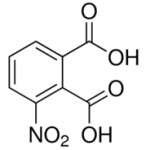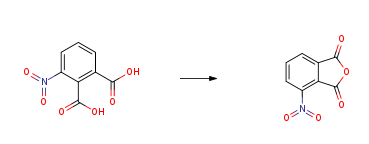3-Nitrophthalic acid CAS#: 603-11-2; ChemWhat Code: 31207
Identification
| Product Name | 3-Nitrophthalic acid |
| IUPAC Name | 3-nitrophthalic acid |
| Molecular Structure |  |
| CAS Registry Number | 603-11-2 |
| EINECS Number | 210-030-8 |
| MDL Number | MFCD00007138 |
| Beilstein Registry Number | 2054269 |
| Synonyms | 1,2-Benzenedicarboxylic acid, 3-nitro- ;3-nitrobenzene-1,2-dicarboxylic acid;3-Nitrophthalic acid;3-Nitrophthalsäure;Acide 3-nitrophtalique;CASNo.: 603-11-2 |
| Molecular Formula | C8H5NO6 |
| Molecular Weight | 211.128 |
| InChI | InChI=1S/C8H5NO6/c10-7(11)4-2-1-3-5(9(14)15)6(4)8(12)13/h1-3H,(H,10,11)(H,12,13) |
| InChI Key | KFIRODWJCYBBHY-UHFFFAOYSA-N |
| Canonical SMILES | c1cc(c(c(c1)[N+](=O)[O-])C(=O)O)C(=O)O |
| Patent Information | ||
| Patent ID | Title | Publication Date |
| CN105669478 | Preparation of 3-amino-O-phthalic acid and derivatives thereof (by machine translation) | 2019 |
| US8653160 | Inclusion complex containing epoxy resin composition for semiconductor encapsulation | 2014 |
| US4141911 | Production of polynuclear dicarboxylatotetrachromium (III) complexes | 1979 |
| US4523041 | Method of purifying 4-fluorophenol | 1985 |
| US4866204 | Method of preparing substituted cyclic carboxylic acids | 1989 |
Physical Data
| Appearance | Off-white to slight yellow crystalline powder |
| Solubility | water: soluble5%, clear to slightly hazy, colorless to faint yellow or tan |
| Refractive index | 1.5282 (estimate) |
| Melting Point, °C | Solvent (Melting Point) |
| 202 – 204 | |
| 218 – 220 | water |
| 214 – 217 | H2O |
| 217 – 218 | benzene, diethyl ether |
| Boiling Point, °C |
| 81.5 – 82 |
| Density, g·cm-3 | Measurement Temperature, °C | Type (Density) |
| 1.74 | -153.15 | crystallographic |
Spectra
| Description (NMR Spectroscopy) | Nucleus (NMR Spectroscopy) | Solvents (NMR Spectroscopy) | Original Text (NMR Spectroscopy) | Comment (NMR Spectroscopy) |
| Chemical shifts | 1H | chloroform-d1 | 1H-NMR (CDCl3) ö: 2.21 (s, 3H), 7.76 (d, 1H), 7.94 (t, 1H), 8.42 (d, 1H), 9.84 (s, 1H). | |
| Chemical shifts | 1H | dimethylsulfoxide-d6 | 1H-NMR (270 MHz, CD3OD): δ8.28(1H,dd,J=7.6,1.2Hz), 8.25(1H,dd,J=7.8,1.2Hz), 7.72(1H,dd,J=7.8,7.6Hz) ppm. | |
| 1H | d(4)-methanol | Signals given | ||
| Chemical shifts | 1H | solid | ||
| NMR |
| Description (IR Spectroscopy) | Solvent (IR Spectroscopy) | Comment (IR Spectroscopy) |
| Bands, Spectrum | potassium bromide | |
| Bands | ||
| Bands | KBr | 1620 – 695 cm**(-1) |
| Description (Mass Spectrometry) | Comment (Mass Spectrometry) |
| spectrum | FAB (fast atom bombardment) |
| negative ion spectroscopy |
| Description (UV/VIS Spectroscopy) | Absorption Maxima (UV/VIS), nm |
| Reflection spectrum, Band assignment, Spectrum | |
| Spectrum | |
| Band assignment | 371 |
| UV/VIS |
Route of Synthesis (ROS)
| Conditions | Yield |
| With thionyl chloride; N,N-dimethyl-formamide In cyclohexane at 5 – 10℃; for 3.83333h; Time; Reagent/catalyst; Solvent; Temperature; Vilsmeier Reaction; Reflux; | 98.9% |
| With acetic anhydride for 2h; Reflux; | 95% |
| With acetic anhydride for 2h; Reflux; | 95.8% |
| With tetrabutylammomium bromide; toluene-4-sulfonic acid; acetic acid In toluene at 100 – 150℃; Concentration; Reagent/catalyst; | 95.8% |
| In acetyl chloride at 51℃; for 3.5h; | 94% |
| With acetic anhydride for 2h; Reflux; | 93% |
Safety and Hazards
| Pictogram(s) |   |
| Signal | Danger |
| GHS Hazard Statements | H315 (100%): Causes skin irritation [Warning Skin corrosion/irritation] H318 (95.22%): Causes serious eye damage [Danger Serious eye damage/eye irritation] H335 (99.52%): May cause respiratory irritation [Warning Specific target organ toxicity, single exposure; Respiratory tract irritation] Information may vary between notifications depending on impurities, additives, and other factors. |
| Precautionary Statement Codes | P261, P264, P271, P280, P302+P352, P304+P340, P305+P351+P338, P310, P312, P321, P332+P313, P362, P403+P233, P405, and P501 (The corresponding statement to each P-code can be found at the GHS Classification page.) |
Other Data
| Transportation | NONH for all modes of transport |
| Under the room temperature and away from light | |
| HS Code | 291739 |
| Storage | Under the room temperature and away from light |
| Shelf Life | 1 year |
| Market Price | USD |
| Druglikeness | |
| Lipinski rules component | |
| Molecular Weight | 211.131 |
| logP | 1.144 |
| HBA | 4 |
| HBD | 2 |
| Matching Lipinski Rules | 4 |
| Veber rules component | |
| Polar Surface Area (PSA) | 120.42 |
| Rotatable Bond (RotB) | 3 |
| Matching Veber Rules | 2 |
| Use Pattern |
| Used as a photosensitive material |
| Used as pharmaceutical intermediate |
| Used as an organic synthesis intermediate |
| Used in synthetic medicines |
| Used as dyes |
| Used as crop protection agents |
Buy Reagent | |
| No reagent supplier? | Send quick inquiry to ChemWhat |
| Want to be listed here as a reagent supplier? (Paid service) | Click here to contact ChemWhat |
Approved Manufacturers | |
| Caming Pharmaceutical Ltd | http://www.caming.com/ |
| Want to be listed as an approved manufacturer (Requires approvement)? | Please download and fill out this form and send back to [email protected] |
Contact Us for Other Help | |
| Contact us for other information or services | Click here to contact ChemWhat |


